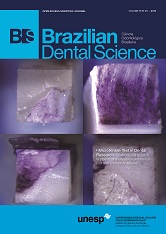Analysis of flexural strength of a self cured acrylic resin used for fabricating provisional restorations with three different types of reinforcements
DOI:
https://doi.org/10.14295/bds.2013.v16i3.905Resumo
Objective: To evaluate the effect of three different types of reinforcements on the flexural strength of a chemically activated acrylic resin.
Materials and Methods: A Universal test machine EMIC 2000 was used at a speed of 5mm/min., to evaluate the flexural strength of 40 test specimens (65mm X 10mm X 3mm) fabricated of chemically activated acrylic resin, distributed into the following four groups: (1) control – without reinforcement; (2) reinforced with 0.7mm stainless steel orthodontic wire; (3) reinforced with Fibrex-lab® glass fiber and; (4) reinforced with Perma-Fiber®glass fiber.
Results: The following flexural strength values were obtained: Group 1 – 80.60 MPa; Group 2 – 95.96 MPa; Group 3 – 105.70 MPa; and Group 4 – 108.70 MPa. The analysis of variance (p < 0.05) showed significant difference among the groups and the Tukey test showed that the control group presented the worst behavior, followed by reinforcement with metal wire, which showed statistically similar results to those of Group 3, with no difference shown between the fiber groups.
Conclusion: Reinforcement with glass fibers present better flexural strength in comparison with the other methods.
Downloads
Downloads
Publicado
Como Citar
Edição
Seção
Licença
TRANSFERÊNCIA DE DIREITOS AUTORAIS E DECLARAÇÃO DE RESPONSABILIDADE
Toda a propriedade de direitos autorais do artigo "____________________________________________________________________" é transferido do autor(es) para a CIÊNCIA ODONTOLÓGICA BRASILEIRA, no caso do trabalho ser publicado. O artigo não foi publicado em outro lugar e não foi submetido simultaneamente para publicação em outra revista.
Vimos por meio deste, atestar que trabalho é original e não apresenta dados manipulados, fraude ou plágio. Fizemos contribuição científica significativa para o estudo e estamos cientes dos dados apresentados e de acordo com a versão final do artigo. Assumimos total responsabilidade pelos aspectos éticos do estudo.
Este texto deve ser impresso e assinado por todos os autores. A versão digitalizada deverá ser apresentada como arquivo suplementar durante o processo de submissão.




























